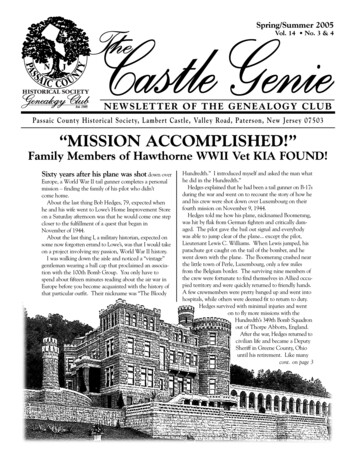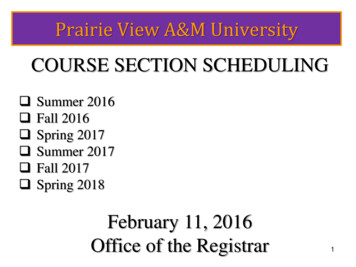
Transcription
Spring/Summer 2005TheVol. 14 No. 3 & 4CastleGenieNEWSLETTER OF THE GENEALOGY CLUBPassaic County Historical Society, Lambert Castle, Valley Road, Paterson, New Jersey 07503“MISSION ACCOMPLISHED!”Family Members of Hawthorne WWII Vet KIA FOUND!Sixty years after his plane was shot down overEurope, a World War II tail gunner completes a personalmission – finding the family of his pilot who didn’tcome home.About the last thing Bob Hedges, 79, expected whenhe and his wife went to Lowe’s Home Improvement Storeon a Saturday afternoon was that he would come one stepcloser to the fulfillment of a quest that began inNovember of 1944.About the last thing I, a military historian, expected onsome now forgotten errand to Lowe’s, was that I would takeon a project involving my passion, World War II history.I was walking down the aisle and noticed a “vintage”gentleman wearing a ball cap that proclaimed an association with the 100th Bomb Group. You only have tospend about fifteen minutes reading about the air war inEurope before you become acquainted with the history ofthat particular outfit. Their nickname was “The BloodyHundredth.” I introduced myself and asked the man whathe did in the Hundredth.”Hedges explained that he had been a tail gunner on B-17sduring the war and went on to recount the story of how heand his crew were shot down over Luxembourg on theirfourth mission on November 9, 1944.Hedges told me how his plane, nicknamed Boomerang,was hit by flak from German fighters and critically damaged. The pilot gave the bail out signal and everybodywas able to jump clear of the plane. except the pilot,Lieutenant Lewis C. Williams. When Lewis jumped, hisparachute got caught on the tail of the bomber, and hewent down with the plane. The Boomerang crashed nearthe little town of Perle, Luxembourg, only a few milesfrom the Belgium border. The surviving nine members ofthe crew were fortunate to find themselves in Allied occupied territory and were quickly returned to friendly hands.A few crewmembers were pretty banged up and went intohospitals, while others were deemed fit to return to duty.Hedges survived with minimal injuries and wenton to fly more missions with theHundredth’s 349th Bomb Squadronout of Thorpe Abbotts, England.After the war, Hedges returned tocivilian life and became a DeputySheriff in Greene County, Ohiountil his retirement. Like manycont. on page 3
The Castle GenieSpring/Summer 2005Club NewsMark Your CalendarThe Passaic County Historical Society GenealogyClub holds meetings 10:00 a.m. at Lambert CastleMuseum on the second Saturday of the monthfrom September through May (unless otherwisespecified). Meeting dates for the 2005-2006 yearare as follows and programs will be announced asthey become known:GENEALOGICAL SEMINAR – FALL 2005“Crossing the Boundaries”Saturday, October 29, 2005 9:30am - 5:00pmat the Salvation Army School for Officer Training201 Lafayette Avenue, Suffern, NYA full-day genealogy seminar will be held in Suffern, NY.It will be co-sponsored by libraries and genealogy organizations from New York and New Jersey, including theNew City Library, NYGB, PCHS, Bergen County,Orange County, and Rockland County. Our PassaicCounty speaker will be Mr. Giacomo DiStefano, Directorof the Paterson Museum, who will speak on industrialdevelopment in this area and how it influencedimmigration to the area and beyond.Saturday, September 10, 2005Saturday, October 8, 2005Saturday, November 12, 2005:Due to Holiday House Boutique at LambertCastle Museum, meeting to be held at Louis BayMemorial Library, 315 Lafayette Avenue,Hawthorne, NJSEMINAR TOPICS: Loyalists Research Documents, & N.Y. - N.JCounterfeiting during the American Revolution. They Went (Digitally) That-a-Way: InternetResources for Tracking Ancestors’ Migrations. From Italy to New Jersey: A Case Study inGroup Migration Cruising Long Island Sound:Tracing its Early Familieswith a Regional View Crossing Water Boundaries: Tracking Immigrants andNew Citizens Whose Secret is it Anyway? An Archivist’s Perspective. Mended Fences: The N.J./N.Y. Boundary Dispute The Orphan Train EraSaturday, December 10, 2005:Due to Holiday House Boutique at LambertCastle Museum, meeting to be held at Louis BayMemorial Library, 315 Lafayette Avenue,Hawthorne, NJSaturday, January 14, 2006Saturday, February 11, 2006Saturday, March 11, 2006Saturday, April 8, 2006Cost: includes catered buffet lunch 60: Member of a participating society. 90: Non-member.Saturday, May 13, 2006For more information and Registration Formgo to: www.crossingtheboundaries.orgOut of the MailbagRockville Maryland member Bill Serchak writes about the importance of obtaining a good understanding of an ancestral village. He email reads part:“I’m planning to write about both Czarna Gora where my grandfather was born and about Nowa Biala where his wife, my grandmother Mary KOLODZIEJ was born. These ‘Village Stories’ will be an essential part of the JEZIERCZAK FAMILY HISTORY. Ithink that without a good understanding of the history and geography of the region, Spis, and the individual villages, anyone reading the family history would miss a great deal of the flavor the life and times of our ancestor.“For that reason, I also will include articles about Austria-Hungary and its colorful history plus another concentrating on the tangled tale of Spis-part of A-H, then Slovak, then Polish. Those 14 villages that passed back and forth during the past two centurieshave to be appreciated in the larger context of the fragmentation and virtual disappearance of Poland itself for around 100 years oruntil 1920.“I used the time in California to good advantage and was able to complete another large portion of grandfather Andrew’s years inPassaic. Now I will be fielding the sections out to all my cousins and asking them for comment, correction and additional input inthe form of documents and photos.There will always be gaps and possibly a ‘brick wall’ or two but I intend to make this familyhistory as complete and accurate as I know how.”2
The Castle GenieMission AccomplishedSpring/Summer 2005the crew and backtrack the history of the plane itself. In gatheringthis information from various resources, it’s important to understandthat WWII records are subject to human error as the data was manually transcribed. As it so happened, a simple transcription errorsent me off on a wild goose chase right at the start.I went looking for Lewis C. Williams, age about 8, in the 1930Census for New Jersey. It was almost too easy. I found a family insouth central New Jersey with a son Lewis C. and spent about aweek trying to locate information about them. Every bit of detail Iturned up did not fit the story as I understood it.I turn turned to what I knew would be a long and involvedprocess – searching the Casualty Lists of the New York Times formention of his name. These lists ran three or four times a week andlisted war casualties from the New York and New Jersey area.Experience told me that the names of the casualties usually appearedseveral weeks or even months after the report of their loss. I finallyfound Lewis C. Williams listed in February of 1945, and it gave hisnext-of-kin’s name as Mrs. Emelie Williams of Hawthorne, New Jersey.Actually it was the errors that moved the search forward. Afterhitting so many roadblocks with that one family I had keyed on, Iapplied the Times information to my search but could not find aLewis or Emelie Williams in Hawthorne, New Jersey. After readingpage after page of names, I noticed something very strange thefamily of Louris and Emilie Williams, with a son named LORRIS,age 8. I went to the hand written records and what do you know?The transcriber had typed exactly what he could see, and he hadcompletely mangled the names. I found the family of Louis, Emilie,and their son Lewis C., living on Lafayette Avenue, in Hawthorne,in 1930. This provided two new names to search for past the dateof his loss in 1944. Things began to move forward again.At this point I wrote to the Passaic County Historical Society,and my request reached the desk of Society President MaryjaneProctor, who was much taken with Bob Hedges desire to return theflag to the Williams family if they could be found. Proctor searchedthe city directories and discovered the same Williams family livingat Lafayette Avenue from the early 1930s all the way into the1960’s. With the knowledge that Lewis Williams grew up locally,she determined what year he must have graduated from high schooland soon was able to provide Bob Hedges and me with his classphoto from 1939.“It was incredible,” said Hedges, “that after 60 years there was aphotograph of my pilot from his high school annual. Dave and Ms.Proctor are first class detectives!”Maryjane Proctor did have to deliver some bad news. The trailof the Williams family abruptly ceased in Hawthorne in 1967.I found Emilie Williams again – or at least someone who couldpossibly be her – in of all places – California. I knew roughly herdate of birth, so as I consulted different resources I keyed on that.I also discovered that our pilot’s father had died in 1967. This waswhen Emilie dropped from the records in New Jersey. I discoveredan Emilie Williams deceased in Encino, California, in 1985.Much as I was glad to be moving forward with the search, havingcovered 41 years since the date of Lewis Williams’ loss, I feared thatthe trail might soon run out.At this point, I posed a question to myself. Why would a womanthen in her 70s pick up and move all the way across the country toCalifornia? It must be that she had some relatives or at least a veryclose friend there. I backed up again – all the waycont. on page 4cont. from page 1WWII veterans, he tried to put the war behind him as he moved onwith his life. But as the years went by, he had a desire to reconnectwith his old Group and Squadron mates. Together they would recallthe good times they had together, and in quieter moments, reflecton the missions they had flown and friends they had lost.In 1999, Hedges returned to Europe to revisit the places of hiswartime service. Stops included his old base at Thorpe Abbotts inEast Anglia and Perle, Luxembourg, where his plane had crashed.He was amazed by the reception he received in Perle. The city haderected a memorial to his plane that specifically noted the loss of thepilot, Lt. Lewis C. Williams. Upon learning of Hedge’s impendingvisit, the city fathers arranged a special dedication ceremony in hishonor. At the ceremony, they presented Hedges with the flag thatflew over the memorial.Hedges was honored to receive the flag on behalf of my crewmatesbut ever since that day had always believed that the people whodeserved to have it were the family of Lewis Williams. Hedge subsequently spent the next six years in a fruitless search for the family.He indicated meeting me at the store was the luckiest thing thatcould have happened, because his search had pretty much reacheda dead end.2nd Lt. Lewis C. Williams as he appeared in Hawthorne High’sClass of 1939 yearbook.I am a military historian who specializes in World War II subjects,with the history of paratroopers and of the Army Air Forces particularfavorites. I have studied various units in detail for over thirty yearsand have helped numerous veterans and families reconnect withtheir own, or a loved one’s, military past. When Bob Hedges toldme about his search for the pilot’s family, all thoughts of weekendhome improvement projects were soon forgotten. We swapped phonenumbers and details, and I immediately began my own search.Dipping into my archival databases, I discovered key informationabout Lewis Williams that would help in the search. Within twodays, I sent Hedges an email with far more information than hehad found in six years of looking.I learned that Williams, like most pilots, entered the service asan enlisted man. From that information, I went on to verify theyear he was born, that he was from New Jersey, where he hadentered the service, and that he was not married when he enlisted.I often find that when researching an historical event that I haveto ‘back up’ in order to move forward. While the events ofNovember 9th, 1944 were crystal clear in Bob’s memory, the factsof the event were something that I have to place in their properperspective. So I began to gather information on the members of3
The Castle GenieMission AccomplishedSpring/Summer 2005Belgium. While there she met a ‘Marraine de Guerre’ – aGodmother of War – one of the local Belgian civilians who adoptthe graves of American servicemen, leaving floral tributes on specialholidays and generally tending to the grave beyond that providedby the American Battle Monuments Commission. The lady EmilieWilliams met there was actually the person who had adopted herson’s grave, and a close friendship naturally followed. Later thisBelgian lady moved to the United States and settled in California.When Louis Williams passed away in 1967, Emilie Williams leftNew Jersey and moved to Encino, California, to be near the womanwho had tended her son’s grave. It was after that that CharlesWilliams family moved from New Jersey to Bellflower, California,returning to Marianne’s mothers hometown. Marianne filled me inon the family details and confirmed all of his research, eventelling me that her brother still lived in Hawthorne andthat his middle name was Lewis, in honor of his cousinthe pilot.“When Dave called our house on Sunday afternoon I knew that something big had come up,” saidBob Hedges. “Usually he sent emails, and theywere always exciting to read – but when he said,‘Bob, I hope you’re sitting down’ I got my wife onthe phone so I wouldn’t miss anything – and boydid he have a story to tell! I was stunned!”Shortly thereafter Bob Hedges was on the phonewith Marianne Teague, his pilot’s cousin.cont. from page 3to the 1910 Census – and started a search for Emilie Williams familybased on her mother and father’s last names. Simultaneously, Ienlisted the help of a WW2 veteran friend who lived near Encino,to find some local information on Emilie. My acquaintance inCalifornia – a World War II paratrooper – made visits to locallibraries, newspapers, and funeral homes and soon found that theperson Berry had identified as pilot Williams’ mother, was in fact theright person. She had made her own arrangements and requestedthat when she passed that she be returned to New Jersey to be buriedwith her husband Louis in Fair Lawn Cemetery, very close to Hawthorne.But that wasn’t the end of the trail that I feared all along. Mrs.Williams had left the name of “a nephew” Charles Williamswho lived in California. There was an address but nophone number, so the process began anew, and I did yetanother genealogical search for this new name. Thenephew was also named Williams, so I realized thatthis meant that Louis Williams had a brother, andthis nephew was his son, and a first cousin to Lewisthe pilot.I found a Charles Williams in the same town thathad been noted on the records for Emilie Williamsand soon learned that he had passed away in 1999.The end of the trail loomed large. A check of the1994 telephone books showed that the person he wasseeking corresponded with the address found by hisparatrooper associate, and this regrettably proved thatCharles Williams had passed on.Summarizing all of this material, I sent an email report to BobHedges on a Saturday morning, holding out hope that the childrenof Charles Williams could still be found and that Hedges wouldstill have a direct kin of Lewis Williams to present his flag to. Imade a few calls to funeral homes near to where Charles Williamshad lived, and one suggested that I contact the Long Beach PressTelegraph, a paper which served Bellflower, California. On a whim,I made the call on a Saturday afternoon, and the news desk phonewas answered by reporter Chris Hanson, who was intrigued by thestory of the return of the flag and checked the papers archives. Noobituary had been published. But he looked in the phone book thatwas handy, and told me that the person at the address he had beengiven was still good for 2003! The next day I called that number,and the phone was answered by Marianne Teague – who just happened to be the daughter of Charles Williams, and therefore the‘first cousin-once removed’ of pilot Lewis Williams.Marianne was well acquainted with the family history as it relatedto Lewis Williams. She was amazed at the extent to which I hadgone to find her family. Only a few days before she and her motherhad been going through some boxes and had come across some of“Aunt Emilie’s” papers and material relating to Lewis. Mariannetold me that she had Lewis’ Purple Heart Medal that was presentedto the family after his loss, and she had been given a ring that oncebelonged to him.Tying up some loose ends and still seeking to qualify all of hisresearch, I asked Marianne if I was correct that Emilie had movedto California after Lewis’ father had passed away to be closer to herrelatives? Now it was time for me to be amazed.Marianne told me that Aunt Emilie had actually traveled toEurope to visit the grave of her son at Henri-Chapelle Cemetery inHandsome and youthful looking,Tailgunner Robert HEDGES, circa 1942.Arrangements are underway for a method whereby the flag canbe properly presented to the Williams family. This search involvedpeople on both coasts and right here in the middle, too. We justhave to figure out how we’re going to do it. Somehow I neverthought that would be the hard part! The Hedges’ and Williams’families have heaped a lot of praise on me, but I have to givethanks and credit where it is due. Maryjane Proctor at the PassaicCounty Historical Society in New Jersey qualified all the informationI was able to discover on that end, and my good paratrooper friendBob Sechrist, ran the ball for us in California. If not for them, thisstory wouldn’t have reached its conclusion. I hope that we are ableto put together a properpresentation ceremonythat they all will beable to attend.Come that day, Mr.Bob Hedges will havecompleted his personalmission by presentingthe U.S. Flag flownover Lewis Williams’memorial inLuxembourg to hispilot’s family.Pathfinder Historian David Berryof Dayton, Ohio4
The Castle GenieSpring/Summer 2005BIOGRAPHY OF JOHN CORNELIUS BOGERT1839 – 1865Joyce R. SvendsenJohn Cornelius Bogert, born 1839 in Paterson, New Jersey, wasmy great-great grandfather. He resided on Morton Street inPaterson with his wife and two children when he enlisted as aSergeant on December 18, 1863 in Paterson. Bogert joined 3rdNew Jersey Volunteer Cavalry Company ––3rd NJ Volunteer Calvary RegimentThe 3rd New Jersey Cavalry Volunteer Regiment (39th NewJersey Volunteers) was organized at Camp Bayard, Trenton,New Jersey and mustered in by Companies as follows:Company A, January 26, 1864Company C, January 22, 1864Company E, January 4, 1864Company F, January 12, 1864Companies G, and H, January 6, 1864Company D, December 2, 1863Company B, January 29, 1864Companies I, K, L, and M, March 24, 1864– March to Annapolis, Md., April 5-7, 1864.– Guard Orange & Alexandria Railroad April 29-May 5.– Attached to Cavalry, 9th Army Corps, Army of thePotomac to May, 1864.– 1st Brigade, 3rd Division, Cavalry Corps, Army of thePotomac and Middle Military Division, to June, 1865.– Defenses of Washington, D.C. to August, 1865.–––Service– Campaign from the Rapidan to the James May 3-June 12, 1864.– Wilderness May 5-7. Near Germanin Ford May 5. Picket onthe Rapidan, May 6. Guard pontoons May 7.– Expedition to Fredericksburg, May 8-9.– Spottsylvania, May 9-12.– Spottsylvania Court House, May 12-21. United States FordMay 19.– North Anna River, May 23-26.– On line of the Pamunkey, May 26-28.– Totopotomoy, May 28-31.– Mechump’s Creek, May 31.– Ashland Station, June 1.– Cold Harbor, June 1-12.– Totopotomoy, Gaines’ Mill, Salem Church, Hawes’ Shop, June 2.– Hawes’ Shop, June 3.– Bethesda Church, June 11.– White Oak Swamp, June 13.– Smith’s Store, near St. Mary’s Church, June 15.– Weldon Railroad, June 20.– Jerusalem Plank Road, June 22-23.– Milford Station, June 27.– Picket duty at City Point until July 16.– Duty at Light House Point, July 16-25.– Before Petersburg, July 25.– Mine Explosion, Petersburg, July 30 (Cos. A and E).– Sheridan’s Shenandoah Valley Campaign: August 7-November 28.– Winchester, August 17.– Summit Point, August 21.– Middleway, August 21.– Near Kearneysville, August 25.– Abraham’s Creek, near Winchester, September 13.––––––––Battle of Winchester, September 19.Near Cedarville, September 20.Front Royal, September 21.Milford, September 22.Waynesboro, September 29.Bridgwater, October 2.Tom’s Brook (Woodstock Races), October 8-9.Picket at Cedar Creek until October 13.Cedar Creek, October 13.Battle of Cedar Creek, October 19.Newtown (or Middletown), November 12.Rude’s Hill, near Mr. Jackson, November 22.Expedition from Kernstown to Lacey’s Springs, December 19-22.Lacey’s Springs, December 21.Sheridan’s Raid from Winchester, February 27-March 24, 1865.Occupation of Staunton, March 2 - Location: Amelia CountyAppomttox Campaign (March-April 1865)April 3, 1865 - Namozine Church. Church still stands wherecavalry clashed on this date. The building was headquartersand hospital after fighting.Principal Commanders were Maj. Gen. George A. Custer[US] and Maj. Gen. Fitzhugh Lee [CS].Brigade Forces were engaged, estimated casualties were 75.In a rearguard cavalry action, a brigade of Union cavalryunder Col. William Well’s (Custer’s Division) attackedFitzhugh Lee’s cavalry near Namozine Church on April 3.Confederate Gen. Rufus Barringer was captured nearby.(CWSAC Reference #VA124)Sailor’s Creek April 6, 1865Appomattox Station April 8, 1865Appomattox Court House April 9, 1865. Surrender of Leeand his army.Expedition to Danville and South Boston April 23-27, 1865March to Washington. D.C., May, 1865Grand Review May 23, 1865Mustered out at Washington, D, C., August l, 1865.During their service, losses to the 3rd New Jersey VolunteerCalvary Regiment were three Officers and 47 Enlisted menkilled, two Officers mortally wounded, and 105 Enlisted menlost by disease. Losses totaled 157 servicemen.My great-great Grandfather John C. Bogert was killed inaction at Sweat House Creek (Taylor’s Plantation), Virginia onApril 3,1865. He left behind his wife Matilda, his son GeorgeS. Bogert, and his daughter Nellie Bogert (who never married).His remains were returned to Paterson by train, and he wasburied there in Sandy Hill Cemetery.When Sandy Hill Cemetery was abandoned, John C. Bogert’sbody was removed to Cedar Lawn Cemetery (Paterson) wherehe lies today next to his wife Matilda and daughter Nellie, in aplot behind Ralph Sultan.His ultimate sacrifice has been memorialized on The Soldiersand Sailors Monument, Eastside Park, Paterson, New Jerseywhich bears his name.Sources used by Historical Data Systems, Inc.:– Register of Officers and Men of New Jersey in the Civil War 1861-65– (c) Historical Data Systems, Inc. at: www.civilwardata.com5
The Castle GenieSpring/Summer 2005THE JERSEY DUTCH LANGUAGEIn an old (PCHS) query addressed to Mr. Jack D. Quackenbushdated April 10th, 1969 concerning the Jersey Dutch language,Mr. Van Cleaf BACHMAN of West Concord, Massachusetts writes:dough that was put in the corner of the pan and baked hard and brownas a treat for the children.A “Slink” or “Slank” was an arm of still water backed up because offlooding – it had no current.When someone was going through a dark room, I often heard grandmother say, “Kike ver you slaut.” (Watch out where you go through).Also, when a meal was made up of leftovers, we were getting “Appestetta mit betta en brooden.” (Monkey meat with butter and bread.)Please bear in mind that most of this is memory of about fifty yearsago. I have no idea of the correct spelling. What I learned was entirelyby hearing what was said.Dear Mr. Quackenbush,For many years I have been interested in the Low Dutch or JerseyDutch language of the Hudson River area – the language of my mother’speople. I have been fortunate in being able to collect a certain amount ofwritten and oral information about it which encouraged me to try to puttogether a careful dictionary of the dialect.Mr. George O. Zabriskie of Honolulu suggested that you might beable to help me in my project. If you remember even one Jersey Dutchrhyme, phrase, or work (or anything which just seems not “according toWebster”), I would greatly appreciate hearing of it. Often the one thinga given person remembers is something which has not previously beenrecorded. Or it may have an interesting pronunciation or meaning.Also, if you could suggest anyone else who might be able to help a bit,I would much appreciate learning that persons name and address.A final comment. These words are like potatoes; you’ve got to dig abit to remember them. I recall one man I talked with not long ago whoregretted his being unable to remember a single word of his grandparent’shad used. So we dropped the subject and started to talk about farming inthe old days. As we talked, he began to remember (and spontaniouslyuse) a number of Dutch words his grandfather has once used on hisfarm.Hoping very much to hear from you, I amSincerely, J.D.Q.In a book titled “The American Language,” published in 1921,author H.L. Mencken writes on the Jersey Dutch language:The Dutch language in the United States is differentiated fromthe original Dutch of Holland by the influence of AmericanEnglish. The so-called Jersey, or Bergen County Dutch, which isspoken by the descendants of seventeenth century Dutch settlers inBergen and Passaic counties, New Jersey. In New York, the Dutchcompletely disappeared many years ago, but in these Jersey countiesit still survives, though apparently obsolescent, and it is spoken bymany persons who are not of Dutch blood, including a few Negro’s.The dialect was originally the South Holland or Flemishlanguage that became mixed with and partially influenced byEnglish. It also borrowed a few plant and animal names from theMindi (Lenâpe-Delaware) Indian language. This Dutch has notsuffered from modern Holland or Flemish immigration, althoughPaterson (the county seat of Passaic County) has at present a largeNetherlands population. The old county people hold themselvesstrictly aloof from these foreigners and when questioned on thedifference between the idioms they reply, “Onze tal äz lex däuts enhoelliz äs Holläns; kwait dääfrent.” (Our language is low Dutch,and theirs is Holland Dutch; quite different). An intelligentFleming or South Hollander with a knowledge of English canfollow a conversation in this Americanized Dutch, but theconverse is not true.The vocabulary shows many signs of English influence, with alarge number of words in daily use borrowed bodily – bottle, town,railroad, cider, smoke, potato, match, good-bye. Others have beenborrowed with changes – säns (since), määm (ma’m), belange(belong), boddere (bother), bääznäs (business), orek (earache).In other cases, English is also apparent, as in blaubääse, a literaltranslation of blueberry (the standard Dutch word is heidebes), inmep’lbom ( maple tree; Dutch, ahoornboom), and in njeuspampir( newspaper; Dutch, nieuwsblad).Very truly yours, Van Cleaf BachmanJohn D. Quackenbush replies to Van Cleaf Bachman via letterdated April 19th, 1968. He writes:Dear Sir,In reply to your letter requesting information about the Jersey Dutchlanguage. My grandmother could speak it if she desired, and as a child Iwould tease her to say things in Dutch. I picked up a bit of it in this way,and we also used a few words and sayings in my parent’s home. However,that was many years ago, and I’m afraid I have forgotten most of it.Here is one saying I recall with a rough translation:“Mox nix ouse, hans der deutal sox en de ouste playse, mit derkogelspielen en der Dutchman’s huis.” (Makes no difference than theturtle splash in the outside pond makes on the endless talk in theDutchman’s house.)All this nonsense was merely to tell a person that what they were doingor saying did not amount to anything.I like the word “Kogelspielen.” A Kogel was a ball or circle, and acircle has no ending. So Kogelspielen was circle talk or endless chatter.From the same source was “Kojeltje.” This was the half-round pieceof crusty bread cut from the end of the loaf.Also in the bread line was “Panne.” This was a little ball of left over6
The Castle GenieSpring/Summer 2005THE VOYAGE OF THE MARION; Winter 1839 is the story of the journey of the founders of the Silk Industryin Paterson, New Jersey, John Ryle and James Mayers, who traveledfrom Macclesfield, England to Paterson, New Jersey in 1839.Written by: Robert A. Mayers, great-grandson of James Mayers andSarah AllisonTwo young men climbed 108 steps alongside a medieval cathedralto reach the higher ground of the ancient Cheshire town ofMacclesfield, England. They emerged into a bustling marketplace,the social and business center of the town since the middle ages.The first Anglo-Saxon settlement was on this site since by thesteps, a steep drop down to the River below provided a natural defense.The looming presence of St. Michael’s Cathedral had dominatedthe market square since 1278. In the center of the market was anancient Celtic stone cross. Proclamations were made to the peasantpopulation from this spot, and early traders had set up their stallsaround the cross. Here all business transactions were made in timebefore the written word. All deals made within the shadow of thecross were considered binding. Tudor timber frame buildings linedthe square housed the town hall, guildhalls, and inns. Butchers,fishmongers, and merchants boisterously hawking cattle, sheep,wool, iron pots, cloth, and corn filled other stalls in from of thebuildings. Farmers from surrounding villages brought their producehere by the horse load.From the high ground, the two looked down on “Waters Green,”the lower town. In ea
Proctor, who was much taken with Bob Hedges desire to return the flag to the Williams family if they could be found. Proctor searched the city directories and discovered the same Williams family living at Lafayette Avenue from the early 1930s all the way into the 1960's. With the knowledge that Lewis Williams grew up locally,










